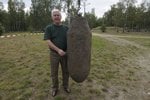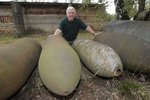syscom3
Pacific Historian
Click the link to see the pics.
The Lethal Legacy of World War II
Unexploded Bombs in Germany: The Lethal Legacy of World War II - SPIEGEL ONLINE - News - International
By David Crossland in Wünsdorf, Germany
Germany remains contaminated with unexploded bombs that are becoming increasingly unstable with age, warns one of the country's most experienced bomb defusers. He has just retired after a perilous career spent tackling the deadly legacy of World War II.
Hans-Jürgen Weise, one of Germany's most experienced bomb disposal experts, will never forget his hairiest moment.
It was in 1997 in the eastern town of Oranienburg and he was squatting in a hole in the ground trying to defuse a 250 kilogram American World War II aerial bomb that builders had found. Its detonator was so bent that he couldn't unscrew it to make the bomb safe.
"I fitted a pneumatic press to tear the detonator out of the bomb remotely. We were 150 meters away and could see what was happening on a TV monitor," Weise, a fit 65-year-old with a ready laugh, told SPIEGEL ONLINE in an interview. "The detonator budged a few centimeters but wouldn't come any further.
"So we decided to detonate the bomb. While everything was being prepared I climbed back down into the pit to retrieve the press from the bomb because those machines cost €20,000," he said. "It was then that I noticed that the detonator had come a bit loose. So I started playing around with it and ended up screwing it out by hand."
"You should have seen the goose bumps on my arm! I didn't think of anything while I was doing it. I could have just waited for it to be detonated. But that's the ambition of the bomb disposer, I suppose. No one said anything at the time. But looking back on it today they say I was mad. And they were right."
Lethal Harvest Each Year
Weise retired at the end of September after spending almost four decades clearing munitions from one of the most bomb-contaminated regions in Europe -- the state of Brandenburg surrounding Berlin. In Brandenburg alone, an average of 631 tons of old munitions from the two world wars and from Soviet army exercises in East German times are found every year by builders, bomb location squads or children playing.
In the whole of Germany, more than 2,000 tons of American and British aerial bombs and all sorts of munitions ranging from German hand grenades and tank mines to Russian artillery shells are recovered each year. Barely a week goes by without a city street or motorway being cordoned off or even evacuated in Germany due to an unexploded bomb being discovered.
Most estimates for the percentage of unexploded bombs range from 5 to 15 percent -- or between 95,000 and 285,000 tons. As Germany hastily rebuilt its cities after the war, authorities didn't have the time or the means to locate and dispose of a large part of that tonnage.
As a result, a deadly legacy has lain dormant beneath Germany's streets ever since.
Daily Callouts
"We get two or three calls a day saying a shell or bomb has been found at construction sites or elsewhere," said Weise, who was head of bomb disposal operations for western Brandenburg. In Brandenburg, Weise and his team of around 70 colleagues disposed of 10,733 tonnes of munitions between 1991 and 2007 at a cost of €259 million, a regional government spokesman said.
Unearthed munitions that can be transported safely are taken to a detonation ground where they are exploded or have their explosives removed. But many bombs -- and all bombs with delay-action detonators -- are too dangerous to be moved and must be either defused or detonated where they are found.
Weise said it will take at least another 20 years before Brandenburg' s bombs are cleared, and that the state is particularly contaminated with American delay-action bombs which have become so unstable that it will soon be impossible to defuse them safely. The bombs are on a hair trigger because their chemical detonators have been worn down by acetone vapors as they have lain lurking in the ground for over 60 years.
Slumbering Bombs on a Hair-Trigger
"In the last few years we've found that the detonators we take out of such bombs are increasingly brittle," Weise said. "Recently we've had three extracted detonators go off with a pissssh sound while they were being transported away, all it took was a bit of vibration. One day such bombs will be so sensitive that no one will be able to handle them. We may have to stop defusing them as soon as next year."
Several people have been in injured in spontaneous bomb explosions in Oranienburg over the years and experts have warned that with the passage of time such detonations are becoming more likely.
An estimated 20,000 delay-action bombs were dropped on Oranienburg during the war because it had a suspected atomic bomb research site, the Heinkel aircraft factory and a pharmaceutical plant. They were designed to explode between two and 146 hours after hitting the ground, to disrupt clearing up work and cause chaos.
But many failed to go off because Oranienburg has soft soil with a hard layer of gravel underneath. That meant bombs would penetrate the earth, bounce off the gravel and come to rest underground with their tips pointing back upwards. In that position gravity stops the chemical detonators from working. They contain a vial of acetone which bursts on impact and is meant to trickle down and dissolve a celluloid disk that keeps back the cocked firing pin.
But when the bomb is pointed upwards, the acetone seeps away from the celluloid, leaving only the vapors to wear the disk down.
Weise has defused a total of 394 large bombs in his career including 47 delay action bombs which tend to be the trickiest.
Eerie Silence
Weise's final mission was in August in the city center of Potsdam, the regional capital of Brandenburg, which came to a standstill after workers found a 250 kilogram British World War II bomb at a construction site. Some 3,000 people were evacuated from the area and the train station was closed as Weise gingerly unscrewing the bomb's detonator with a wrench.
"When you're on your own in that pit with the bomb in the middle of a city, it's strange how everything suddenly goes totally quiet," said Weise. "Sometimes even the birds stop singing. That's always the point when you feel edgy. After the Potsdam bomb last month I thought, you've been lucky so many times, that's the last one today, now you'll stop."
Weise admits he must have had a lot of luck in his career which started in 1970 when he began helping to locate and transport munitions in what was then communist East Germany. He got his qualification to defuse bombs in 1983.
Until his retirement, the wall of his office in the town Wünsdorf south of Berlin was covered with photos of him and members of his team smiling with relief as they stand next to defused bombs hanging from hooks or lying on the ground like trophies from a perilous safari.
Weise said he soon lost his fear of bombs but never stopped respecting them. "After I passed my exam and had to defuse my first bomb on my own I did get a bit nervous," he recalled. "Suddenly there was no one behind me telling me what to do. I was totally alone. As you kneel down and apply the wrench you think, 'am I doing this right?' But then I remembered exactly what I'd learned and after that I wasn't afraid anymore."
Weise said British bombs with conventional mechanical detonators were relatively easy to defuse with a wrench because the detonators were made of brass and didn't rust.
Sudden Death
"I always say a bit of fear isn't bad because it makes you careful. But fear can also make you do uncontrolled things. I have respect for every type of munitions because I've seen what can happen," he said. "I saw two men killed on the detonation ground while they were sorting munitions. After you witness something like that it takes you a few weeks before you can go near a bomb again. It keeps you careful."
Three bomb disposal workers have died handling munitions at the Brandenburg detonation ground since 1950. But no defusers have been killed.
The search for bombs intensified across Germany in the early 1990s after the British and Americans handed over air reconnaissance photos taken after the bombing raids. Holes in the ground amid the craters showed the likely locations of unexploded bombs, sometimes to an accuracy of less than two meters. But the photos can't pinpoint every dud. Bomb disposal teams spent the 1990s searching in high priority locations such as schools, hospital, residential areas and busy streets.
While the detonators are decaying underground, the TNT in the bombs isn't. In 2006 a worker was killed when his bulldozer struck a bomb near a motorway in southern Germany. Eyewitnesses said the explosion tossed the bulldozer through the air like a toy.
Search Slowing Due to Shortage of Money
Apart from aerial bombs, Weise's team removes grenades, mines, artillery shells and guns of all types. Brandenburg is so contaminated because it was here that whole German divisions were annihilated in 1945 in last stands against the Soviet armies advancing on Berlin.
The state has cleared 12,541 hectares of munitions-infested land, but a further 391,000 hectares, or 1,500 square miles, of contaminated area remain. The proactive searching has slowed down due to a shortage of money, and most bombs these days are found by chance, said Weise.
"No new staff are being hired and the experienced ones are coming to retirement age," said Weise. "Our detonation ground is short of staff especially during vacation times." Weise said he definitely won't encourage any of his three grandchildren to follow in his footsteps. "They may not be as lucky as their grandpa was."


